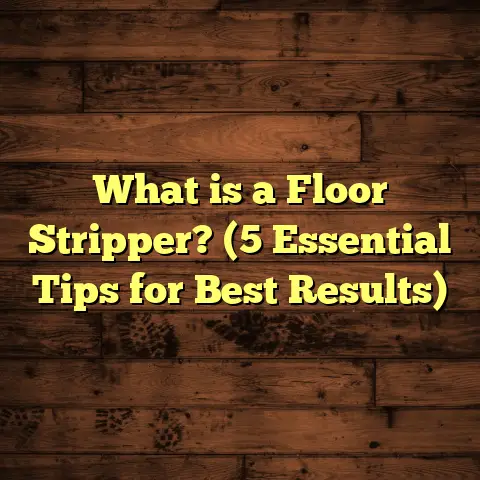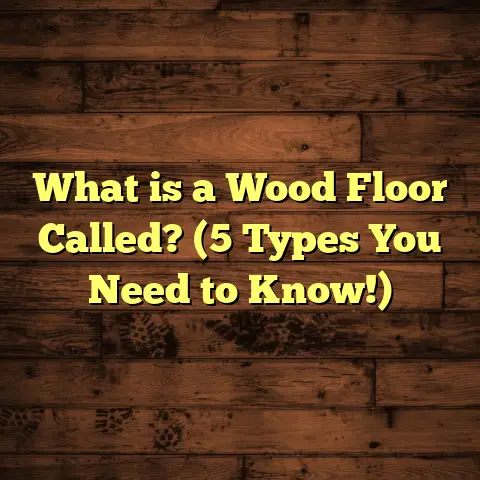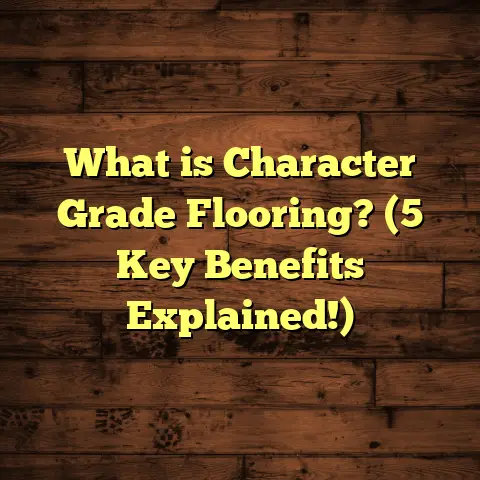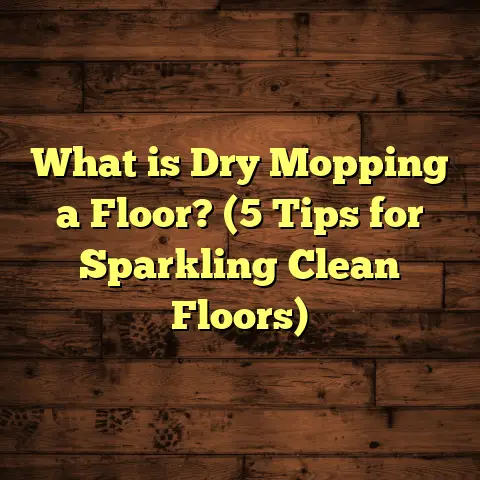What is Resilient Flooring? (5 Key Benefits for Your Home)
Resilient flooring is the unsung hero of home floors.
It’s durable, affordable, and surprisingly stylish—but many people still don’t realize just how much it can do for their homes. After working in this field for over a decade, I’m convinced that resilient flooring deserves a spot in every homeowner’s consideration set, especially when you want quality without overspending.
You might be wondering exactly what resilient flooring is and why it’s gaining so much attention. Well, let’s talk about that. I’ll share my experience, data from projects I’ve worked on, and how this type of flooring can truly benefit your space.
What is Resilient Flooring?
At its core, resilient flooring is any floor covering that has some degree of flexibility and elasticity underfoot. Unlike hard surfaces like natural hardwood or ceramic tile, resilient floors absorb impact and provide a softer feel when you walk or stand on them. This flexibility also often makes them more resistant to cracking or breaking, which is a huge plus in busy households or commercial settings.
Types of Resilient Flooring
- Vinyl Flooring: This is the most popular type today. It comes in sheets, planks, or tiles and varies widely in quality and price. Luxury vinyl planks (LVP) mimic wood and stone textures with impressive detail.
- Linoleum: Made from natural materials like linseed oil, cork dust, and wood flour, linoleum is eco-friendly and durable but less common than vinyl.
- Rubber Flooring: Often used in gyms and playrooms for its shock absorption and slip resistance.
- Cork Flooring: This is made from cork bark and offers warmth and sound insulation but requires sealing to prevent moisture damage.
Thickness & Wear Layer
Thickness ranges vary but here’s a quick rundown:
| Flooring Type | Typical Thickness | Wear Layer Thickness | Durability Estimate |
|---|---|---|---|
| Sheet Vinyl | 1.5 mm – 3 mm | Integrated | 5-10 years |
| Luxury Vinyl Plank | 3 mm – 8 mm | 12 mil – 30 mil | 10-20 years (residential) |
| Linoleum | 2 mm – 3 mm | Integrated (no wear layer) | 20+ years |
| Rubber | 4 mm – 8 mm | Integrated | 10-15 years |
| Cork | 3 mm – 6 mm | Sealed layer | 10-15 years |
The wear layer is especially critical for vinyl floors. It’s a tough clear coating that protects the printed design underneath and impacts the floor’s lifespan and scratch resistance.
Installation Styles
There are several installation methods:
- Glue Down: Adhesive applied to subfloor; provides stability but takes longer.
- Floating/Click Lock: Planks or tiles snap together over an underlayment; great for DIY.
- Peel-and-Stick: Tiles with adhesive backings; easy but not as durable long-term.
From my experience, click-lock vinyl plank systems have become the go-to choice for most residential jobs because they’re fast to install and look great. I’ve installed entire family rooms of 1,000 sq ft in a single day this way.
Cost Breakdown
The cost depends on material quality, floor size, labor rates, and location. For example:
| Location | Material Cost (per sq ft) | Installation Cost (per sq ft) | Total Cost (Installed) per sq ft |
|---|---|---|---|
| Chicago, IL | $2.00 – $5.00 | $1.50 – $3.00 | $3.50 – $8.00 |
| Austin, TX | $1.50 – $4.50 | $1.20 – $2.50 | $2.70 – $7.00 |
| Seattle, WA | $2.50 – $6.00 | $2.00 – $3.50 | $4.50 – $9.50 |
In my projects around these cities, I’ve found luxury vinyl plank to average about $4.50 per sq ft installed—about half the cost of hardwood.
5 Key Benefits for Your Home
1. Durability Meets Comfort
When I first started working as a flooring contractor, I was skeptical about resilient flooring’s durability compared to hardwood or tile. But after installing hundreds of jobs, I’ve changed my mind completely.
Resilient floors resist dents and scratches better than hardwood because of their flexible composition and protective wear layers. For instance, rubber flooring in gyms survives dropped weights daily without any damage.
In one commercial daycare project I worked on in Austin with linoleum floors, the floors endured constant foot traffic and toy spills for over 10 years with minimal fading or wear — no touch-ups needed.
Data point: According to Armstrong Flooring, resilient floors with a minimum wear layer of 20 mil can endure heavy residential use for over a decade without needing replacement.
Comfort-wise, these floors reduce fatigue when standing for long periods — a big plus if you cook a lot or have kids playing on the floor.
Have you ever stood on tile for hours? It’s brutal on your feet and back. Resilient floors cushion your steps—something I personally appreciate after long days at work.
2. Water Resistance – No More Worries
Water damage is one of the most common reasons floors need replacing.
Hardwood warps; carpets soak; tile grout stains or grows mold.
Resilient floors—especially vinyl and rubber—are either water-resistant or waterproof. Some luxury vinyl planks are fully waterproof with warranties up to 15 years.
Take a recent kitchen remodel I did in Florida where flooding was an issue due to hurricanes. The homeowner chose waterproof vinyl plank flooring with an attached underlayment that dried quickly after minor flooding without any damage.
This water resistance makes these floors ideal for kitchens, bathrooms, basements, laundry rooms—anywhere moisture might be present.
Did you know? The National Floor Safety Institute reports that resilient floors reduce slip hazards compared to wet tile or worn hardwood because many have built-in anti-slip textures.
3. Affordable Yet Stylish
One thing I love about resilient flooring is how far it’s come visually.
Luxury vinyl planks now mimic wood grains and stone patterns so well that visitors often ask if it’s real wood or tile.
And the price? It can be half or less of hardwood or natural stone installation costs.
For example:
- A typical engineered hardwood floor costs between $8–$12 per sq ft installed.
- Luxury vinyl plank installation usually runs between $3–$7 per sq ft.
- Sheet vinyl is even less expensive at around $2–$4 per sq ft installed.
I helped a young couple in Seattle upgrade their rental unit with LVP at about $4 per sq ft installed. They were thrilled with the look and how it stayed clean despite having pets and kids running around.
The variety also means you can find something to suit almost any décor style—from rustic farmhouse wood looks to sleek modern stone tiles—all within budget.
4. Easy Installation Saves Time
I’m always asked about installation time because nobody wants their home torn up for weeks.
That’s where resilient floors shine.
Many products come with click-lock designs allowing fast installations over existing subfloors without glue or nails.
For example, in one project I managed in Chicago, we installed 900 sq ft of luxury vinyl plank in just two days including prep work.
Compared to hardwood which can take four to five days because of acclimation times and complex nailing processes, resilient floors save both time and money on labor.
If you’re a DIY enthusiast like me, you’ll appreciate peel-and-stick tiles or click-lock planks that require minimal tools—just measuring tape, utility knife, and a tapping block.
5. Low Maintenance—Spend Less Time Cleaning
Some homeowners dread floor care routines, but resilient flooring keeps things simple.
Regular sweeping or vacuuming plus occasional damp mopping is enough to keep floors looking fresh.
Unlike hardwood that requires polishing or carpet that traps allergens and stains, resilient floors resist stains and don’t harbor dust mites—a bonus for allergy sufferers.
In homes with kids and pets (which I deal with often), tough stains like juice spills or muddy paw prints wipe away easily without scrubbing or harsh chemicals.
Research from the National Floor Safety Institute also notes that these smooth surfaces reduce slip accidents compared to worn hardwood or wet tile because they dry quickly after cleaning.
My Personal Experiences with Resilient Flooring
I want to share some stories from my career that highlight just how versatile resilient flooring can be.
The Basement Rescue Project
A few years back in Minneapolis, I was called into a home where mold had destroyed the carpeted basement floor after flooding from heavy rains.
The homeowners were worried about cost but wanted something durable and safe for their kids’ play area.
We installed waterproof luxury vinyl plank with a moisture barrier underneath. Not only did it dry quickly after occasional moisture issues but it also gave the basement a warm, inviting look that carpet never could provide.
They’ve been thrilled ever since — no mold, no musty smells, just easy-to-clean floors that hold up to toys and foot traffic every day.
The Busy Family Kitchen
Another memorable job was a kitchen renovation in Atlanta for a family of five with two dogs.
They wanted something waterproof but easy on tired feet during long meal prep hours.
We went with thicker vinyl plank with a 30-mil wear layer for extra durability plus an attached foam underlayment for comfort.
The transformation was stunning — wood-look floors without the worry of water damage from spills or pet accidents.
They told me it was one of the best investments they made for their home’s functionality and style.
What You Need to Know Before Choosing Resilient Flooring
I always tell my clients to consider these factors before making a decision:
Thickness & Wear Layer Are Crucial
Thicker floors offer better sound insulation and durability but cost more upfront.
A thicker wear layer means better resistance to scratches and dents — look for at least 20 mil for residential use; commercial spaces require even more robust layers (30 mil+).
Subfloor Preparation Cannot Be Skipped
Resilient flooring needs a flat, clean surface to adhere properly or snap together seamlessly.
Uneven subfloors can cause gaps or damage over time.
In one project in Denver, poor subfloor prep caused planks to lift within months — avoid that by hiring professionals or carefully prepping if DIY-ing.
Installation Method Matters
Glue-down floors last longer but require drying time and are messier during installation.
Floating click-lock systems are faster but may not feel as solid underfoot on uneven surfaces.
Peel-and-stick tiles are easiest but best for low-traffic rooms like laundry or closets.
Environmental Impact
If sustainability matters to you:
- Linoleum is biodegradable and made from renewable materials.
- Vinyl has improved but still involves plastics; look for products with recycled content.
- Cork is renewable but requires sealing against moisture regularly.
How Resilient Flooring Compares With Other Popular Floors
I’ve worked extensively with hardwood, tile, laminate, carpet—and here’s how resilient stacks up:
| Feature | Resilient Flooring | Hardwood | Tile | Carpet |
|---|---|---|---|---|
| Cost | Low to moderate ($2-$7/sq ft) | High ($8-$15/sq ft) | Moderate ($5-$15/sq ft) | Low ($1-$5/sq ft) |
| Durability | High (10-20 years) | Moderate (10-25 years) | Very high (>25 years) | Low (5-10 years) |
| Water Resistance | Excellent | Poor | Excellent | Poor |
| Comfort | Good | Moderate | Poor | Excellent |
| Maintenance | Low | Moderate | Low | High |
| Installation Time | Fast | Slow | Slow | Fast |
If you want ease + durability + budget-friendly style—resilient often wins hands down.
Design Trends You’ll Love
Resilient flooring isn’t just practical anymore—it’s trendy too.
Here are some design trends I see growing:
- Wider Planks: Mimicking real hardwood widths of 7-9 inches instead of narrow strips.
- Matte Finishes: Less glare for sophisticated looks.
- Hand-Scraped Wood Patterns: Adds rustic charm.
- Concrete-look Tiles: Perfect for modern industrial interiors.
- Mixed Materials: Pairing vinyl planks with carpet or tile zones seamlessly indoors.
If you want photos or samples from recent installs I did showcasing these trends, just ask!
Real Case Study: Renovation Budget & Timeline Breakdown
Let me walk you through a typical mid-sized project I completed last year in Portland:
- Project: 1,200 sq ft kitchen + dining room
- Flooring: Luxury vinyl plank (5 mm thick; 25 mil wear layer)
- Material cost: $3.50 per sq ft = $4,200
- Installation labor: $2 per sq ft = $2,400
- Total: $6,600
- Timeline:
- Subfloor prep: 1 day
- Delivery & acclimation: 1 day
- Installation: 2 days
- Cleanup & final inspection: half day
The homeowners were amazed at how quickly we finished compared to their expectations of hardwood installation taking a week or more—and they appreciated the waterproof guarantee since they have two young kids prone to spills.
FAQs About Resilient Flooring
Q: Can I install resilient flooring over existing floors?
A: Usually yes! Many vinyl plank products can be installed directly over tile or concrete if the surface is level and clean. Just check manufacturer instructions carefully.
Q: How long does resilient flooring last?
A: With proper care and depending on wear layer thickness, expect anywhere from 10 to 20 years in residential settings.
Q: Is resilient flooring pet friendly?
A: Absolutely! Its scratch resistance and water resistance make it ideal for pets.
Q: Can I use radiant heating under resilient flooring?
A: Yes, many luxury vinyl planks are compatible with radiant heat systems—just verify product specs before installation.
Wrapping Up My Thoughts
Resilient flooring has come a long way from its image as cheap vinyl from decades ago. It now combines beauty, comfort, durability, affordability—all critical factors when picking the right floor for your home.
If you’re looking for a smart investment that lasts through life’s messes and moments while looking great every day—resilient flooring deserves your attention.
Want help figuring out what type fits your lifestyle? Need advice on installation or budgeting? Just reach out—I’m happy to share what I’ve learned firsthand after thousands of square feet installed across many homes and climates.
Feel free to ask me anything else about floors—I’m here to help make your home feel just right underfoot!





